| Pages:
1
2 |
thorazine
Harmless

Posts: 27
Registered: 4-3-2009
Member Is Offline
Mood: No Mood
|
|
Hi!
Woelen, sorry, my mistake! What added was NaClO3 like not_important said. I tried it because I saw a paper where they use NaClO3 as oxidant in the
extraction of vanadium.
As I said I started all over again. I found a drug store here that sells H2O2 (30%). But even it didn't went very well.
I added 12.29g of FeV to 120 mL of HCl (30%). Let boil for about an hour and a half and filtered.
When filtered it there was a lot of (metal?) residue, as you can see: 
I obtained a reddish solution, iodine-like , which filtered. Here's the photo: 
I figured it would take about 10 mL H2O2, but with this amount just turned dark - green. Continued to add up to a total of 35 mL, until the foam
becomes bright orange in the top (its difficult to see the real colour of solution). Boiled a few minutes as not_importande said, and in the end the
solution was too dark. While boiling slowly added 14 g of Na2CO3. In the end I got a car oil-like solution!!
Thats here:

I filtered and i've got a mud-like ppt.

What might have gone wrong? The Vanadium not been dissolved in its entirety? Oxidation was not complete? Other metals precipitated at the end - i know
that V is on the solution, but whats that crap in the filter? Any ideias?
Thanks! :
PS - Next week the guy in the drug store will receive nitric acid (60%). Could it be an option to dissolve this, right?
[Edited on 20-5-2010 by thorazine]
|
|
|
12AX7
Post Harlot
    
Posts: 4803
Registered: 8-3-2005
Location: oscillating
Member Is Offline
Mood: informative
|
|
If it wasn't completely oxidized, you may have magnetite. Is it magnetic?
Tim
|
|
|
woelen
Super Administrator
        
Posts: 8012
Registered: 20-8-2005
Location: Netherlands
Member Is Offline
Mood: interested
|
|
The dark red iodine-like color can perfectly be explained. This is due to a peroxo complex in strongly acidic medium. If you have this, then certainly
you have the vanadium in solution.
The powder you still have after dissolving the ferrovanadium could well be (impure) carbon. Many metal alloys contain considerable amounts of carbon,
which do not dissolve when the rest of the alloy does dissolve. This reminds me of dissolving aluminium from a hardware store in hydrochloric acid. I
always have a dark grey precipitate left from such aluminium and you probably have the same here.
The dark iodine/like liquid now should be boiled for quite some time in order to destroy the complex. This indeed can make the liquid blue or green.
The vanadium in oxidation state +5 is capable of oxidizing hydrochloric acid to chlorine and then itself becomes blue vanadyl. Did you smell any
chlorine gas during the boiling.
Now, if you add Na2CO3 then iron will precipitate, together with other metals, but your vanadium also will precipitate if it is in oxidation state +4!
This is not what you want. Vanadium in oxidation state +4 only dissolves in strongly alkaline solution, giving the brown hypovanadate ion, V4O9(2-). I
can imagine that sodium carbonate is not sufficiently alkaline and that you get a precipitate of vanadyl hydroxide (VO(OH)2), which is dark grey.
You either have to assure that the vanadium is in oxidation state +5 before adding Na2CO3 (e.g. add NaClO3, but not peroxide as that rebuilds the
peroxo complex), or you have to add NaOH in order to have the iron precipitated and the vanadium in solution again.
You could try the latter with your mud in the filter.
If I were you, I first would try things on a test tube scale. In that way you don't loose as much of the chemicals as you do now and you produce less
environmentally problematic waste.
Summarizing:
vanadium in oxidation state +4 forms a blue solution in neutral and acidic media, which contain VO(2+).
vanadium in oxidation state +4 forms a dark grey precipitate of VO(OH)2 in neutral to moderately basic media.
vanadium in oxidation state +4 forms a brown soluble anionic species V4O9(2-)
vanadium in oxidation state +5 forms a pale yellow solution in strongly acidic media, which contain VO2(+).
vanadium in oxidation state +5 forms a deep orange precipiate of V2O5.nH2O at pH around 3.
vanadium in oxidation state +5 forms a pale soluble yellow anionic species in moderately alkaline solutions.
vanadium in oxidation state +5 forms a colorless solution in strongly alkaline media, which contain VO4(3-).
With peroxide, vanadium in oxidation state +5 forms a deep red/brown peroxo complex at low pH and a bright yellow peroxo complex at high pH and a dark
blue peroxo complex at very high pH and very high concentration of H2O2.
Vanadium in oxidation state +4 does not form peroxo complexes. This is oxidized to state +5 by hydrogen peroxide and if there is excess hydrogen
peroxide then the peroxo complex is formed.
|
|
|
tetrahedron
Hazard to Others
  
Posts: 210
Registered: 28-9-2012
Member Is Offline
Mood: No Mood
|
|
reaction of V2O5 and Na2CO3
V2O5 + Na2CO3 ---> 2NaVO3 + CO2
28.50g V2O5 (pottery grade; excess) and 17.48g Na2CO3 (also pottery grade; not sure about the hydration
state) were weighed and added into a 200ml Erlenmeyer flask. about 150ml deionized H2O was rapidly added. the mix started bubbling
immediately but did not heat up. at this point the color was still the dark yellow/light orange of V2O5. the mix was left for
about 1h and shaken occasionally. then it was heated in a water bath to about 50°C, shaken, and left for another hour. finally, the mix was brought
to a gentle boil and swirled until the reaction looked complete. during this step the color changed to a dark orange/reddish brown, while some
chunks/flakes were observed floating around (these had a "charred" aspect: partly yellow, partly black). after cooling, the flask looked as in the
picture. does this look normal?
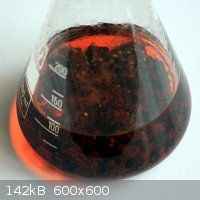
[Edited on 14-10-2012 by tetrahedron]
|
|
|
blogfast25
International Hazard
    
Posts: 10562
Registered: 3-2-2008
Location: Neverland
Member Is Offline
Mood: No Mood
|
|
@tetrahedron:
You may consider yourself lucky that some V2O5 dissolved anyway because these pottery grade oxides are often calcined and not very reactive. And
sodium carbonate isn’t a strong base to start with. I have some pottery grade V2O5 but have never tried to dissolve it in anything, so I’m just
talking in general and not from personal experience with that oxide.
The bubbling also suggests that some carbonate was neutralised.
I would filter off the solution and try dissolving the filter cake (presumed unreacted V2O5) in hot (simmering), strong NaOH or KOH. Also, try using
an excess alkali, not an excess V2O5. I assume you want a solution of orthovanadate?
|
|
|
tetrahedron
Hazard to Others
  
Posts: 210
Registered: 28-9-2012
Member Is Offline
Mood: No Mood
|
|
thanks blogfast for the info. no, i'm interested in the metavanadate, that's why i avoided the strong NaOH. the vanadium pentoxide
from the pottery supply had a nice "yellow cake" appearance, just slightly dark, definitely not black like someone else's. i used an excess because i
didn't want any carbonate in the product. it's also possible and desirable that the metal impurities present precipitate as carbonate (rust color). of
course i plan on recycling the unreacted vanadium.
the filtrate has a mandarin peel color, with a chrome yellow meniscus:
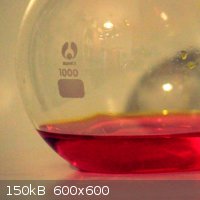
edit. in a cylinder it's obvious that a darker "phase" is settling on the bottom of a lighter one..confusing
[Edited on 14-10-2012 by tetrahedron]
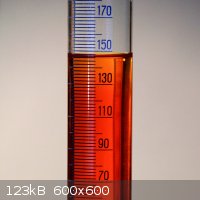
edit. the lower layer is rather dense..addition of another 76mL H2O went to the upper layer, which turned a bright yellow.
the cylinder was thoroughly shaken to mix the layers, then 20.86g (NH4)2SO4 dissolved in ~80mL H2O, but
contrary to expectation no sudden precipitation occurred. the solution slowly turned cloudy. left in a salt-ice-water bath an orange deposit formed
(~6mL), while the whole solution turned bright yellow. if there's ammonium metavanadate in there, it must be heavily contaminated.
btw with a similar procedure the home scientist seems to obtain quite a different result:
http://www.youtube.com/watch?v=KUHO1DKKyG4
[Edited on 14-10-2012 by tetrahedron]
|
|
|
blogfast25
International Hazard
    
Posts: 10562
Registered: 3-2-2008
Location: Neverland
Member Is Offline
Mood: No Mood
|
|
His result is different, possibly because his pottery V2O5 seems to have dissolved better than yours, thus giving higher yield?
Try dissolving the orange precipitate is as little an amount of hot water as possible, then allow to cool and ice. You might get better quality
ammonium metavanadate that way...
So the initial reaction appears to be V2O5 + Na2CO3 == > 2NaVO3 + CO2.
Nice video, BTW...
[Edited on 15-10-2012 by blogfast25]
|
|
|
tetrahedron
Hazard to Others
  
Posts: 210
Registered: 28-9-2012
Member Is Offline
Mood: No Mood
|
|
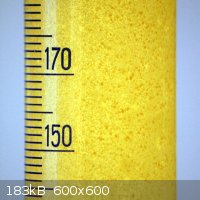
i was surprised to find that overnight a whitish precipitate covered the whole length of the cylinder. the liquid phase (light yellow/green) was
decanted off. after shaking with ~100mL hot H2O the coating went into suspension, yielding an opaque yellow liquid looking very much like
orange juice. after a while, on top of the old orange sediment there was a distinct pale yellow layer, fading more and more to white toward the top. i
cannot explain why this precipitate (arguably NH4VO3) did not form immediately upon cooling, but took several hours instead.
pics follow asap.
[Edited on 16-10-2012 by tetrahedron]
|
|
|
blogfast25
International Hazard
    
Posts: 10562
Registered: 3-2-2008
Location: Neverland
Member Is Offline
Mood: No Mood
|
|
Quote: Originally posted by tetrahedron  |
i cannot explain why this precipitate (arguably NH4VO3) did not form immediately upon cooling, but took several hours instead.
pics follow asap.
[Edited on 16-10-2012 by tetrahedron] |
I wouldn't worry about it. 'Delayed action crystallisation' isn't uncommon.
Going by Wiki's solubility data (temperature dependence) on NH4VO3 something might be gained from icing the solution, to squeeze the last bit of
product out...
I think I might try this synth sometime soon...
|
|
|
AJKOER
Radically Dubious
    
Posts: 3026
Registered: 7-5-2011
Member Is Offline
Mood: No Mood
|
|
Personally, I would use Vinegar (acetic acid) and liquid Bleach (NaOCl). The HOCl formed readily attacks and slowly dissolves Iron especially well,
even in dilute solutions, in the presence of the acetate to produce an obvious soluble Ferric salt (red-brown). Note, without the acetate and in a
closed bottle (no air), a Ferrous salt (green solution) is formed (verify by forming the HOCl from the addition of H2CO3 to NaOCl).
Alternatively, one can also use the common etching solution mix of HCl/H2O2. Then, proceed as outlined by Woelen.
[Edited on 17-10-2012 by AJKOER]
|
|
|
tetrahedron
Hazard to Others
  
Posts: 210
Registered: 28-9-2012
Member Is Offline
Mood: No Mood
|
|
thanks, that's relieving.
i finally managed to isolate two distinct precipitates: a heavy orange one, and a light white one. the white one really likes to stick to the
vertical walls of the container.
i also noticed a puzzling phenomenon: the yellow supernatant turns clear upon heating (orthovanadate? i only used sodium carbonate so the solution
shouldn't be very alkaline).
|
|
|
blogfast25
International Hazard
    
Posts: 10562
Registered: 3-2-2008
Location: Neverland
Member Is Offline
Mood: No Mood
|
|
Quote: Originally posted by AJKOER  | Personally, I would use Vinegar (acetic acid) and liquid Bleach (NaOCl). The HOCl formed readily attacks and slowly dissolves Iron especially well,
even in dilute solutions, in the presence of the acetate to produce an obvious soluble Ferric salt (red-brown). Note, without the acetate and in a
closed bottle (no air), a Ferrous salt (green solution) is formed (verify by forming the HOCl from the addition of H2CO3 to NaOCl).
Alternatively, one can also use the common etching solution mix of HCl/H2O2. Then, proceed as outlined by Woelen.
[Edited on 17-10-2012 by AJKOER] |
AJ:
Has this been experimentally verified or is this one of your ‘HOCl’ based theoretical schemes? If you have verified it, what’s the ratio of
vinegar/bleach used? Commercial bleach is alkaline and vinegar is only about 0.8 M acetic acid: get the ratio of vinegar/bleach wrong and you end up
with a solution containing sodium acetate and sodium hypochlorite, neither use nor ornament…
You talk about ‘HOCl formed’. How, prey, tell? HOCl, although quite unstable, is a strong acid. Now you’re claiming that mixing a weak acid
(acetic acid) with the dissolved (and dissociated) salt of a strong acid (sodium hypochlorite) somehow yields that strong acid. But it doesn’t.
Equilibrium theory shows very clearly that if you mix, for instance weak acetic acid with sodium chloride solution, nothing really happens other than
the weak dissociation of the acetic acid, the chloride ions being essentially spectator ions.
You’d also like me to believe that the hypochlorite will not oxidise Fe (II) to Fe (III), yet hypochlorite is one of the most powerful oxidising
agents we know of, so much so that, as shown in another thread, it can oxidise Cr (III) to chromate (VI)!
|
|
|
tetrahedron
Hazard to Others
  
Posts: 210
Registered: 28-9-2012
Member Is Offline
Mood: No Mood
|
|
due to impure reagents and many losses i was only able to isolate 3.16g of crude NH4VO3
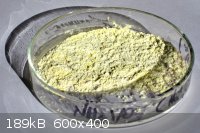
maybe someday i'll attempt this exhausting procedure again, this time with technical grade V2O5 and excess
Na2CO3, as in Thompson's video.
|
|
|
blogfast25
International Hazard
    
Posts: 10562
Registered: 3-2-2008
Location: Neverland
Member Is Offline
Mood: No Mood
|
|
Nice looking product but disappointing yield...
|
|
|
elementcollector1
International Hazard
    
Posts: 2684
Registered: 28-12-2011
Location: The Known Universe
Member Is Offline
Mood: Molten
|
|
Would it be practical to isolate vanadium from high-speed tool steel (1-5% V)? The nearest pottery shop is a long way away...
Elements Collected:52/87
Latest Acquired: Cl
Next in Line: Nd
|
|
|
blogfast25
International Hazard
    
Posts: 10562
Registered: 3-2-2008
Location: Neverland
Member Is Offline
Mood: No Mood
|
|
The trip to that pottery shop is worth an awful lot of HCl! 
Seriously, if V was a precious metal, I'd say 'go for it' any day. But even at the 5 % level? Get yourself some used vanadium steel spanners from
eBay, if you're gonna go the recycling route...
[Edited on 3-6-2013 by blogfast25]
|
|
|
elementcollector1
International Hazard
    
Posts: 2684
Registered: 28-12-2011
Location: The Known Universe
Member Is Offline
Mood: Molten
|
|
Hmm. Well, okay... I'll save up so I can pick up some other stuff on the way there. (Nd2O3, etc...
http://www.seattlepotterysupply.com/Merchant2/merchant.mvc?S...)
Elements Collected:52/87
Latest Acquired: Cl
Next in Line: Nd
|
|
|
| Pages:
1
2 |